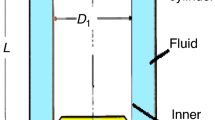Abstract
The speed of sound was measured in gaseous WF6 using a highly precise acoustic resonance technique. The data span the temperature range from 290 to 420 K and the pressure range from 50 kPa to the lesser of 300 kPa or 80% of the sample's vapor pressure. At 360 K and higher temperatures, the data were corrected for a slow chemical reaction of the WF6 within the apparatus. The speed-of-sound data have a relative standard uncertainty of 0.005%. The data were analyzed to obtain the ideal-gas heat capacity as a function of the temperature with a relative standard uncertainty of 0.1%. These heat capacities are in reasonable agreement with those determined from spectroscopic data. The speed-of-sound data were fitted by virial equations of state to obtain the temperature dependent density virial coefficients. Two virial coefficient models were employed, one based on square-well intermolecular potentials and the second based on a hard-core Lennard–Jones intermolecular potential. The resulting virial equations reproduced the sound-speed data to within ±0.005% and may be used to calculate vapor densities with relative standard uncertainties of 0.1% or less. The hard-core Lennard–Jones potential was used to estimate the viscosity and the thermal conductivity of dilute WF6. The predicted viscosities agree with published data to within 5% and can be extrapolated reliably to higher temperatures.
Similar content being viewed by others
REFERENCES
Zahlenwerte und Funktionen, Band II, Teil 2, Landolt-Börnstein (pringer-Verlag, Berlin-Göttingen/Heidelberg, 1960).
E. F. Westrum, Pure Appl. Chem. 8:187 (1964).
V. V. Malyshev, Teplofiz. Vysokikh Temp. 11:1010 (1973).
K. A. Gillis and M. R. Moldover, Int. J. Thermophys. 17:1305 (1996).
J. J. Hurly, Int. J. Thermophys. 20:455 (1999).
A. Heintz and R. N. Lichtenthaler, Ber. Bunsenges Phys. Chem. 80:962 (1976).
A. R. H. Goodwin and M. R. Moldover, J. Chem. Phys. 95:5236 (1991).
K. A. Gillis, Int. J. Thermophys. 18:73 (1997).
K. A. Gillis, Int. J. Thermophys. 15:821 (1994).
K. A. Gillis, A. R. H. Goodwin, and M. R. Moldover, Rev. Sci. Instrum. 62:2213 (1991).
J. W. S. Rayleigh, Theory of Sound (Dover, New York, 1945).
M. W. Chase, C. A. Davies, J. R. Downey, D. J. Frurip, R. A. McDonald, and A. N. Syverud, J. Phys. Chem. Ref. Data 14:1166 (1985).
M. W. Chase, Private Communication (National Institute of Standards and Technology, Gaithersburg, MD, 1999).
G. Nagarajan, Bull. Soc. Chim. Belg. 71:77 (1962).
G. Nagarajan and D. C. Brinkley, Z. Naturforsch. 26A:1658 (1977).
J. P. M. Trusler, Int. J. Thermophys. 18:635 (1997).
C. G. Maitland and E. B. Smith, Chem. Phys. Lett. 22:443 (1973).
T. Kihara, Rev. LMod. Phys. 25:831 (1953).
E. A. Mason and T. H. Spurling, The Virial Equation of State (Pergamaon Press, Oxford, 1969).
R. J. Dulla, J. S. Rowlinson, and W. R. Smith, Mol. Phys. 21:229 (1971).
R. F. Boisvert, S. E. Howe, D. K. Kahaner, and J. L. Springmann, The Guide to Available Mathematical Software, NISTIR 90-4237 (1990).
B. M. Axilrod and E. J. Teller, J. Chem. Phys. 11:299 (1943).
J. O. Hirschfelder, C. F. Curtiss, and R. B. Bird, Molecular Theory of Gases and Liquids (Wiley, New York, 1954).
A. Eucken, Phys. Z 14:324 (1913).
R. C. Reid, J. M. Prausnitz, and T. K. Sherwood, The Properties of Gases and Liquids, 3rd. ed. (McGraw-Hill, New York, 1977).
K. A. Gillis, J. B. Mehl, and M. R. Moldover, Rev. Sci. Instrum. 67:1850 (1996).
P. Morizot, J. Ostorero, and P. Plurien, J. Chem. Phys. 70:1582 (1973).
A. Heintz and R. N. Lichtenthaler, Ber. Bunsenges Phys. Chem. 80:962 (1976).
Author information
Authors and Affiliations
Rights and permissions
About this article
Cite this article
Hurly, J.J. Thermophysical Properties of Gaseous Tungsten Hexafluoride from Speed-of-Sound Measurements. International Journal of Thermophysics 21, 185–206 (2000). https://doi.org/10.1023/A:1006617223481
Issue Date:
DOI: https://doi.org/10.1023/A:1006617223481




